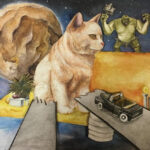Discovering your cat has vomited can be alarming, especially when it’s a yellow liquid. Cat vomiting is a common issue, and the color and content can offer clues about the cause. If you’ve noticed your cat throwing up yellow liquid, you’re likely seeing bile. But what exactly is bile, why do cats vomit it, and when should you be concerned? This guide will delve into the reasons behind Cat Vomiting Bile, helping you understand when it’s a minor issue and when it signals a need for veterinary attention.
What is Bile and Why is My Cat Vomiting Yellow Liquid?
Bile is a yellowish-green fluid produced by the liver and stored in the gallbladder. Its primary role is to aid in the digestion of fats in the small intestine. The yellow color comes from bilirubin, a byproduct of the breakdown of red blood cells. Normally, bile is released into the digestive tract after a meal to help process food.
However, if a cat’s stomach is empty for a prolonged period, bile can back up and irritate the stomach lining. This irritation can lead to your cat vomiting bile, resulting in the expulsion of yellow liquid. Think of it as the stomach being empty and the bile having nothing to digest, leading to it being regurgitated.
Image of a cat looking unwell with a concerned owner in the background
Alt text: Concerned cat owner observing their sick cat who is potentially vomiting bile, highlighting the worry associated with pet health issues.
Sometimes, the yellow vomit might not always be just bile. It could also indicate that your cat has ingested something yellow, such as a yellow toy, food coloring, or even a yellow cleaning product. While less common, it’s important to consider this possibility.
Generally, if your cat occasionally vomits yellow bile and is otherwise behaving normally, it might not be an immediate emergency. However, it’s crucial to understand the various reasons behind this type of vomiting to determine the appropriate course of action.
Common Causes of Cat Vomiting Bile
Several factors can contribute to a cat throwing up yellow bile. Understanding these causes is the first step in addressing the issue and ensuring your feline friend’s well-being.
1. Empty Stomach and Infrequent Meals
The most frequent reason for a cat to vomit bile is simply an empty stomach. Cats have small stomachs and a faster metabolism compared to humans. If they go for extended periods without food, bile can accumulate in the stomach, causing irritation and leading to vomiting. This is especially true for cats who eat only one or two large meals a day.
- Irregular Feeding Schedules: If your cat’s feeding schedule is inconsistent, or if meals are skipped, they are more prone to vomiting bile.
- Fasting Before Procedures: If your cat is scheduled for surgery or a procedure requiring fasting, they might vomit bile due to an empty stomach.
- Bilious Vomiting Syndrome (BVS): Some cats suffer from Bilious Vomiting Syndrome, a condition where bile refluxes into the stomach, causing irritation and vomiting, particularly in the morning before eating.
To prevent bile vomiting related to an empty stomach, ensure your cat has regular, appropriately sized meals throughout the day. Consider feeding smaller, more frequent meals, especially if your cat is prone to this issue.
2. Hairballs
Hairballs are another common culprit behind cat vomiting, and they can sometimes be mixed with bile. Cats are meticulous groomers, and during grooming, they ingest loose hair. This hair can accumulate in the stomach, forming hairballs.
- Grooming and Hair Ingestion: As cats groom themselves, their barbed tongues trap loose hair, which is then swallowed.
- Undigested Hair: Cat hair is indigestible and can clump together in the stomach.
- Irritation and Vomiting: The presence of hairballs can irritate the stomach lining, triggering vomiting to expel the hairball. This vomit may contain bile, food, and hair.
While occasional hairballs are normal, frequent hairballs, especially accompanied by bile and other symptoms, might indicate an issue. Regular grooming, hairball-control diets, and hairball remedies can help minimize hairball formation and related vomiting.
Image of cat grooming itself, highlighting hairball potential
Alt text: A cat diligently grooming its fur, illustrating the process of hair ingestion that can lead to hairball formation and subsequent vomiting.
3. Dietary Issues
Certain dietary factors can also lead to cats vomiting bile.
- Food Sensitivities or Intolerances: Just like humans, cats can have sensitivities or intolerances to certain food ingredients. These can cause gastrointestinal upset and vomiting, sometimes including bile.
- Sudden Diet Changes: Abrupt changes in your cat’s food can disrupt their digestive system and lead to vomiting. Introduce new foods gradually.
- Spoiled Food or Toxins: Ingesting spoiled food or toxins can irritate the stomach and cause vomiting, which might include bile. Ensure your cat’s food is fresh and keep potential toxins out of reach.
If you suspect dietary issues, consult your veterinarian about hypoallergenic diets or gradual food transitions. Always ensure your cat has access to fresh, high-quality food.
4. Underlying Health Conditions
In some cases, persistent or frequent vomiting of bile can be a symptom of an underlying medical condition. These conditions require veterinary diagnosis and treatment.
- Inflammatory Bowel Disease (IBD): IBD is a chronic inflammatory condition affecting the digestive tract, which can cause vomiting, diarrhea, and weight loss.
- Pancreatitis: Inflammation of the pancreas can lead to various digestive issues, including vomiting bile.
- Liver Disease: Since bile is produced by the liver, liver problems can directly impact bile production and flow, potentially causing vomiting.
- Kidney Disease: Kidney issues can also lead to nausea and vomiting in cats.
- Hyperthyroidism: An overactive thyroid gland can sometimes cause gastrointestinal upset, including vomiting.
- Gastrointestinal Obstruction: Blockages in the intestines can lead to bile reflux and vomiting. This is a serious condition requiring immediate veterinary attention.
If your cat’s vomiting is frequent, accompanied by other symptoms like lethargy, loss of appetite, weight loss, or changes in behavior, it’s crucial to seek veterinary care to rule out or address any underlying health issues.
When is Cat Vomiting Bile a Cause for Concern?
While a single episode of vomiting yellow bile might not be alarming if your cat is otherwise healthy and behaving normally, there are situations when it becomes a serious concern.
Seek immediate veterinary attention if your cat exhibits any of the following along with vomiting bile:
- Frequent Vomiting: Vomiting bile multiple times in a day or several days in a row is not normal and warrants a vet visit.
- Lethargy or Weakness: If your cat seems unusually tired, weak, or less responsive, it could indicate a more serious problem.
- Loss of Appetite or Refusal to Eat: A decreased appetite or complete refusal to eat, especially combined with vomiting, is a significant warning sign.
- Dehydration: Signs of dehydration include dry gums, sunken eyes, and skin tenting (when you gently pinch and lift the skin, it doesn’t spring back quickly).
- Abdominal Pain: If your cat is showing signs of abdominal pain, such as restlessness, hiding, or reacting defensively when you touch their belly, it could be serious.
- Vomiting Blood: If you see blood in the vomit (bright red or coffee-ground appearance), it’s an emergency.
- Diarrhea: Vomiting accompanied by diarrhea can quickly lead to dehydration and requires veterinary attention.
- Weight Loss: Unexplained weight loss along with vomiting is a concerning symptom that needs investigation.
- Changes in Behavior: Any significant changes in your cat’s usual behavior, like increased hiding, aggression, or vocalization, could be related to an underlying health issue causing vomiting.
In less urgent cases, but still requiring veterinary consultation:
- Recurring Bile Vomiting: If your cat vomits bile occasionally, even without other symptoms, but it happens regularly, it’s best to consult your vet to identify the cause and prevent potential problems.
- Uncertainty: If you are unsure about the cause of your cat’s vomiting or are worried, it’s always better to err on the side of caution and contact your veterinarian.
Image of a veterinarian examining a cat, emphasizing professional care
Alt text: A veterinarian carefully examining a cat, highlighting the importance of professional veterinary care for diagnosing and treating cat vomiting bile.
What to Do When Your Cat Vomits Bile
If your cat vomits bile, here’s a step-by-step guide on what to do:
- Observe Your Cat: Pay close attention to your cat’s overall condition and behavior. Are they acting normally otherwise? Are they eating and drinking? Note any other symptoms.
- Withhold Food for a Short Period: If it’s an isolated incident and your cat is otherwise well, withhold food for 2-4 hours to allow the stomach to settle. Ensure they have access to fresh water.
- Offer Small, Bland Meals: After the fasting period, offer a small amount of a bland, easily digestible food like boiled chicken (no skin or bones) or plain cooked rice. Observe if they can keep it down.
- Monitor for Further Vomiting: Watch for any further episodes of vomiting. If the vomiting continues or worsens, or if other symptoms appear, contact your veterinarian immediately.
- Contact Your Veterinarian: If you are concerned, if the vomiting is frequent or accompanied by other symptoms, or if you are simply unsure what to do, call your veterinarian. They can provide guidance over the phone and advise if an examination is necessary.
Preventing Cat Vomiting Bile
While you can’t always prevent vomiting, especially if it’s due to an underlying condition, you can take steps to minimize the likelihood of bile vomiting, particularly those related to empty stomachs and hairballs.
- Establish Regular Feeding Schedules: Feed your cat at consistent times each day. Consider smaller, more frequent meals to prevent long periods without food.
- High-Quality Diet: Feed your cat a high-quality, balanced cat food that is appropriate for their age and health needs.
- Hairball Management: If your cat is prone to hairballs, implement hairball management strategies:
- Regular Grooming: Brush your cat regularly to remove loose hair.
- Hairball Diet: Consider a diet formulated to help reduce hairball formation.
- Hairball Remedies: Use hairball lubricants or supplements as recommended by your veterinarian.
- Gradual Diet Changes: Introduce any new foods gradually over 7-10 days to avoid digestive upset.
- Provide Fresh Water: Ensure your cat always has access to fresh, clean water to prevent dehydration, especially if they have vomited.
- Regular Veterinary Checkups: Routine veterinary checkups are crucial for early detection and prevention of underlying health conditions that could cause vomiting.
Conclusion
Cat vomiting bile can be a common occurrence, often linked to an empty stomach or hairballs. While occasional vomiting of bile may not be an immediate emergency if your cat is otherwise healthy, it’s important to be vigilant and observe for any accompanying symptoms or persistent vomiting. Understanding the potential causes of cat vomiting bile and knowing when to seek veterinary care is essential for ensuring your cat’s health and well-being. When in doubt, always consult with your veterinarian – they are your best resource for addressing any concerns about your cat’s health.


